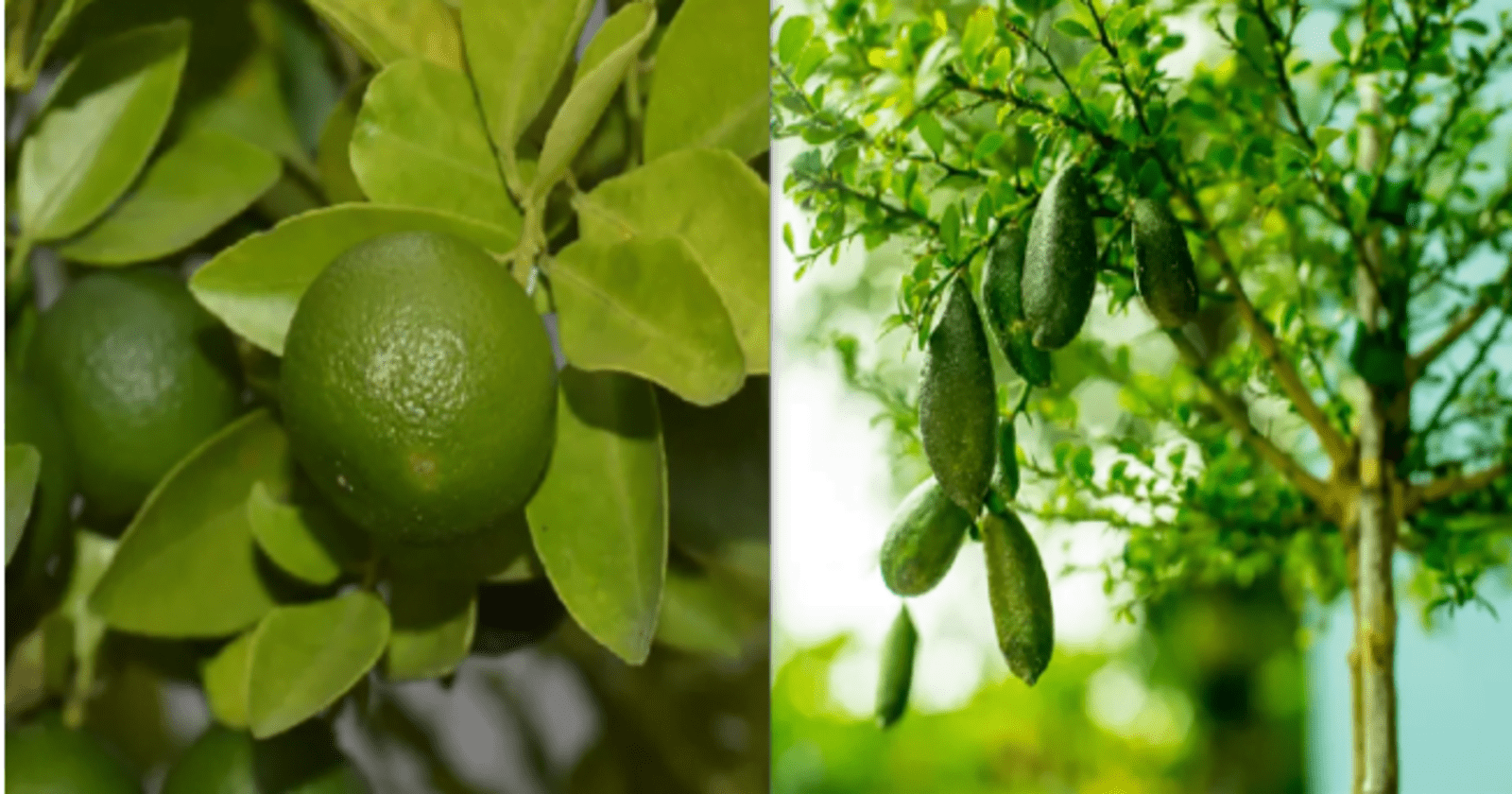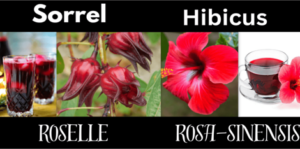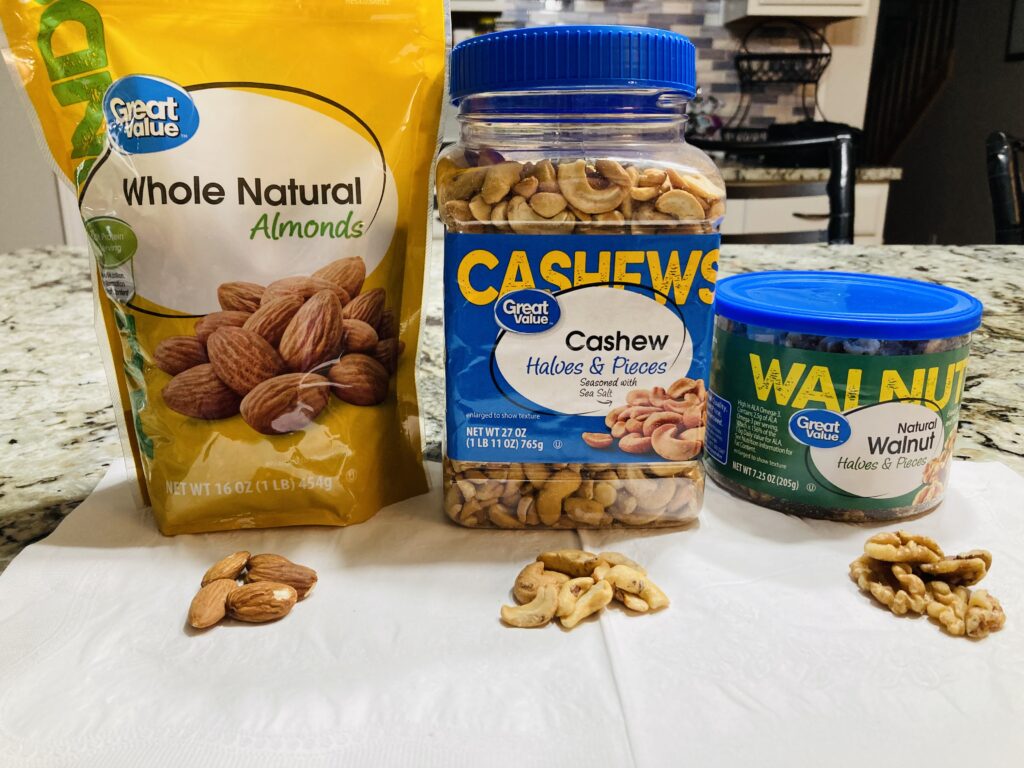Key limes small, round spherical citrus fruits ,thin, smooth, glossy green skin which turn slightly yellow hue as they ripen. Finger limes are elongated citrus fruits with a caviar-like texture, containing tiny juice-filled pearls. While both are citrus fruits, key limes are traditional and widely used, while finger limes offer a unique texture and appearance, often used as a gourmet garnish.
Finger limes and key limes, though both belonging to the citrus family, are distinctive varieties that captivate the palates of culinary enthusiasts around the world. Each possessing its own unique characteristics, these diminutive fruits add a burst of vibrant flavor to a wide array of dishes. The finger lime, also known as Citrus Australasia, is a rare gem native to the rainforests of Australia, celebrated for its caviar-like pearls of citrusy goodness.
Differences between Key Lime vs Finger Lime
| Key Lime | Finger Lime |
|---|---|
| Citrus aurantiifolia | Citrus australasica |
| Small, round | Elongated, finger-like |
| Greenish-yellow when ripe | Varies (green, pink, red, yellow, purple) |
| 1–2 inches in diameter | 2–4 inches in length |
| Tart, aromatic, used in cooking and drinks | Tangy vesicles, “lime caviar,” used as garnish |
| Sharp, tart, slightly bitter | Tangy, slightly sweet, citrusy |
| High | Moderate |
| Southeast Asia, popularized in Florida Keys | Native to Australian rainforests |
| Key lime pie, cocktails, marinades | Garnishes, gourmet dishes, desserts |
| High in vitamin C, antioxidants, fiber | Rich in vitamin C, folate, potassium |
| Widely available, especially in tropical and subtropical regions | Limited, considered a gourmet ingredient |
| Generally affordable | More expensive due to limited supply |
| Room temperature (short-term) or refrigerated | Refrigerated or frozen |
| Warm, sunny climates or indoors in containers | Similar to Key Limes but requires specific care related to native conditions |
| Widely used in various recipes | Popular in high-end cuisine and innovative recipes |
| Smooth outer skin, juicy pulp | Rough, bumpy skin, caviar-like vesicles |
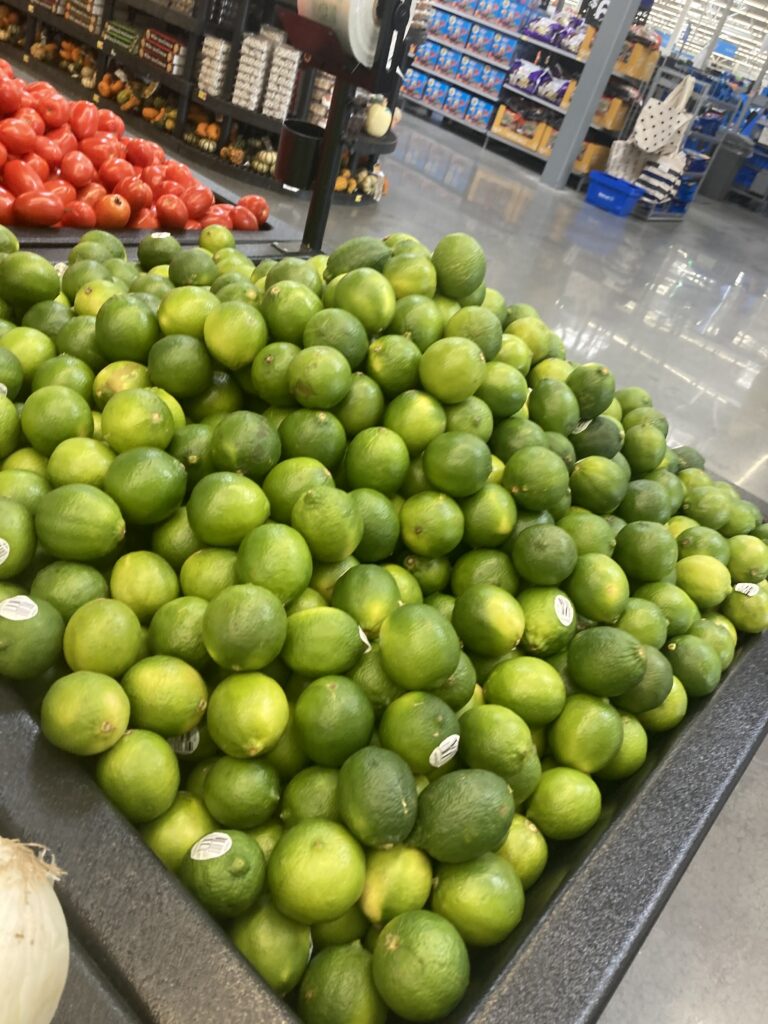
What is Finger Lime?
The finger lime tree, scientifically known as Citrus australasica (also known as the Australian finger lime or caviar lime), bears unique citrus fruits that defy conventional expectations. Available in a spectrum of colors, from vibrant reds to soothing greens, these fruits house a multitude of tiny, juicy vesicles bursting with intense flavor. Notably, tending to a finger lime tree is a straightforward endeavor, making it an accessible choice for enthusiasts. When left unpruned, it can flourish into a luxuriant hedge, while in other contexts, it can assume the graceful stature of a petite tree or be elegantly contained in a manageable pot.

What dose finger lime Taste like ?
- Citrus Intensity: Finger lime has a strong citrus flavor, more intense and concentrated than regular limes. It’s tangy and sharp, providing a refreshing burst of acidity.
- Complex Notes: Along with its tartness, finger lime often has subtle hints of herbaceous and floral notes, which add complexity to its flavor.
- Mild Sweetness: There’s a slight sweetness that balances the acidity, making it versatile for both savory and sweet dishes.
- Aroma: The aroma of finger lime is fresh and zesty, with a slightly earthy undertone, complementing its vibrant taste.
Finger Lime description
- Height range: 2–7 m (6 ft 7 in – 23 ft 0 in)
- Leaf size: 1–6 cm (0.39–2.36 in) long, 3–25 mm (0.12–0.98 in) wide
- Leaf characteristics: Small, glabrous, notched tip, crenate towards the apex
- Flower color: White
- Petal length: 6–9 mm (0.24–0.35 in)
- Fruit charateristics: Cylindrical, 4–8 cm (1.6–3.1 in) long, sometimes slightly curved
- Fruit colors: Various, including pink and green
The finger lime has gained popularity as a gourmet bushfood in recent years, although the specific timeframe is not mentioned. The tiny, spherical juice vesicles, often referred to as “pearls,” are reminiscent of “lime caviar.” They serve as an exquisite garnish or can be incorporated into a variety of recipes. When consumed, the fresh vesicles provide a lively burst of tangy flavor, akin to effervescence. The fruit’s juice is both acidic and reminiscent of traditional lime juice. Additionally, finger limes are utilized in the creation of marmalades and pickles. Furthermore, the dried peel of the finger lime can be employed as a distinctive and flavorful spice.

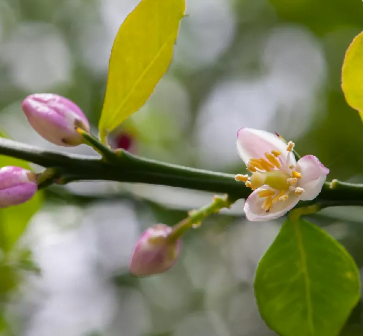
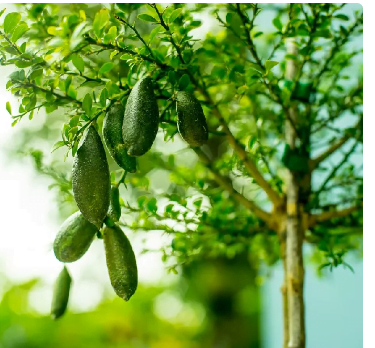
In cultivation, the finger lime plant follows similar growing practices to other citrus species. It may encounter pests and diseases necessitating pest management in agricultural settings. These potential issues encompass scale insects, caterpillars, gall wasps, and limb dieback. Notably, research has confirmed that finger limes do not serve as host plants for fruit flies, alleviating concerns about them posing a quarantine risk for importing countries.
Since the 1970s, studies have identified a wild variety of C. Australasica that exhibits significant resistance to Phytophthora Citrophthora root disease. This discovery has led to a crossbreeding initiative involving finger lime, aimed at producing disease-resistant citrus rootstock. As of 2020, researchers have also embarked on projects involving C. Australasica to develop strategies for combatting Citrus greening disease.

Additionally, the CSIRO (Commonwealth Scientific and Industrial Research Organization) has successfully created numerous citrus hybrids by crossing finger lime with conventional citrus species. These hybrids have resulted in the emergence of various cultivars that yield finger limes in an array of colors, ranging from delicate shades of pink to deep blue-green. The finger lime is recognized for boasting the broadest spectrum of color variation within the Citrus genus. The pulp, containing the juice vesicles, can be found in hues spanning from pale lime-green to pale pink, coral, and even scarlet.
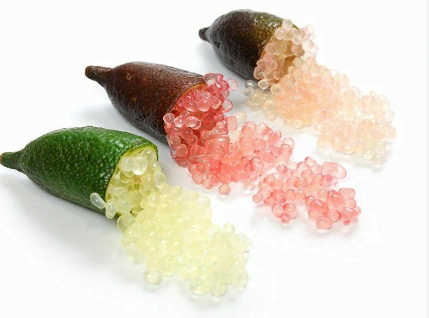
Different types of finger lime
Due to their flavor and bright colors, the herb and its fruits are adored in culinary creations by food lovers. Its sour taste and strong fragrance make it ideal to be used for cooking jams, garnishes, and sauces. It can also be added to many alcoholic and non-alcoholic beverages.
Nutritional Content Of Finger Lime
- Water: Approximately 90 grams
- Vitamin C: 29 milligrams
- Calories: 28
- Carbohydrates: 9 grams
- Dietary Fiber: 4 grams
- Protein: Negligible (very low)
- Fats: Negligible (very low)
- Iron: Present (specific amount not provided)
- Potassium: Present (specific amount not provided)
- Vitamin A: Present (specific amount not provided)
- Vitamin E: Present (specific amount not provided)
Health benefits of Finger Lime
- Enhances Immunity Level: Abundance of Vitamin C helps strengthen the immune system, making the body less prone to infections.
- Augments Eye Health: Significant amount of Vitamin A in finger limes helps maintain healthy eyes and may delay age-related macular degeneration.
- Delays Signs Of Ageing: High Vitamin C content supports healthier and more youthful-looking skin, fighting free radicals and promoting collagen production.
- Fights Signs Of Scurvy: Being a great source of Vitamin C, finger limes can help combat symptoms of scurvy, promoting healthy gums.
- Combat Age-Related Diseases: Rich in Vitamin E, finger limes, particularly the pink variety, offer antioxidant properties that may alleviate symptoms of age-related diseases related to nerves, joints, brain, and heart.
- Lowers Elevated Blood Pressure Levels: Significant potassium content encourages blood vessels to widen, reducing pressure and potentially lowering the risk of heart-related issues.
- Fights Iron-Deficiency Anaemia: Contains decent amounts of iron, which supports the production of red blood cells, reducing the risk of iron-deficiency anaemia.
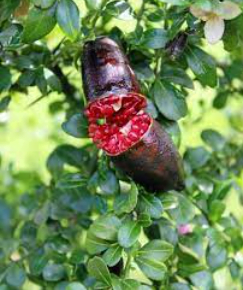

Remember, while finger limes offer these health benefits, it’s important to consume a balanced diet and consult a healthcare professional for personalized advice on your health and nutritional needs.
Uses of Finger Lime
- Globular Finger Lime Extracts in Recipes:
- Extracts from globular finger limes can enhance a variety of recipes.
- Marmalades and Pickles with Finger Lime Extracts:
- Finger lime extracts are used to create flavorful marmalades and pickles.
- Dried Finger Lime Peel as a Flavoring Ingredient:
- Dried finger lime peel adds a unique flavor to many dishes.
- Finger Lime as Dressing, in Jams, and Sauces:
- Finger lime is versatile, serving as a dressing, jam, or sauce ingredient.
- Active Floating Garnish in Alcoholic Drinks:
- Finger lime acts as a dynamic garnish in various cocktails like mojitos, margaritas, and martinis.

Mojito Cheesecake Parfaits with Finger Lime Caviar
- Freeze-Dried Finger Lime for Asian Curries and Gravies:
- Freeze-dried finger lime is a perfect garnish for Asian curries and gravies.
- Assortment on Desserts, Cakes, and Muffins:
- Finger limes add a delightful touch to desserts, cakes, and muffins.
- Substitute for Lime in Soft or Hard Drinks:
- Finger lime can be a lime substitute in both soft and alcoholic beverages.
- Pulp Garnish on Tacos, Tofu, Greens, and Fruit Salads:
- The pulp from finger lime skin is a zesty garnish for tacos, tofu, greens, and fruit salads.
- Incorporating Finger Limes in Marmalades and Desserts:
- Finger limes are a tasty addition to marmalades and desserts like cheesecake, ice cream, cookies, and cakes.
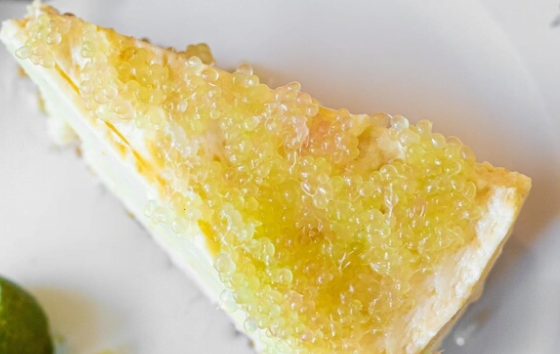
- Sweet Dishes and Fresh Vegetables/Salads:
- Due to their tangy flavor and crunchy texture, finger limes enhance sweet dishes and complement fresh vegetables and fruit salads.
- Pairing with Pasta Dishes:
- Finger lime pairs wonderfully with a range of pasta dishes.
- Visually Appealing Garnish for Rich Desserts:
- The caviar-like appearance of finger limes makes them a visually appealing garnish for puddings, ice creams, and various rich and creamy desserts.
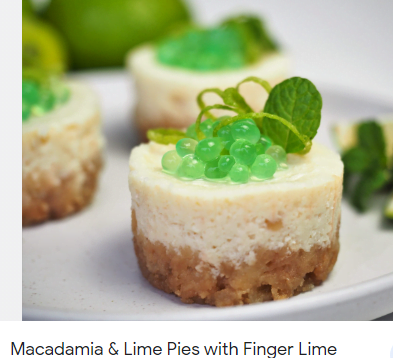
Shelf life & Cost of finger lime
Once harvested, finger limes can last about four weeks in the refrigerator. Even when frozen, they keep their taste and texture, making them a good alternative to lemons and limes that don’t fare well with long freezing times after harvest.
Finger limes remain uncommon but are highly sought after in the market. They command premium prices in California’s specialty fruit markets, ranging from $30 per pound for standard fruit (0.35 to 0.39 ounces per fruit) to around $50 per pound for premium varieties (over 0.5 ounces per fruit).
What is Key Lime
The key lime, scientifically referred to as “Citrus aurantiifolia,” has its origins rooted in Southeast Asia, but is now closely associated with the Florida Keys, and the Caribbean where it flourishes in the subtropical climate. Its petite, round shape and distinctive tartness make it a cornerstone in the realm of desserts and beverages. As we delve deeper into the nuanced characteristics of these two citrus varieties, a fascinating culinary journey unfolds, revealing the diverse ways in which they elevate the world of gastronomy.

KEY LIME
Description of key lime
- Common Name: Key Limes, Mexican Lime , West Indian limes.
- Scientific Name: Citrus aurantiifolia
- Growth Habit: Shrubby tree, up to 5 meters (16 feet) in height
- Thorns: Many thorns present on the branches
- Trunk: Trunk rarely grows straight, with branches often originating far down on the trunk
- Leaves: Ovate, 25–90 mm (1–3+1⁄2 inches) long, resembling orange leaves (hence the scientific name “aurantiifolia”)
- Flowers: Diameter of approximately 25 mm (1 inch), yellowish white with a light purple tinge on the margins
- Flowering and Fruiting: Flowers and fruit appear year-round, most abundant from May to September in the Northern Hemisphere
- Dwarf Varieties: Exist for indoor cultivation during winter and in colder climates
- fruit Size: Small, measuring 1-2 inches in diameter
- Shape: Round
- Skin: Thin, yellowish
- Flavor: Brisk and distinct, with a more tart and bitter taste compared to other limes
- Sugar Content: Higher than lemons
- Citric Acid Content: Higher than lemons
- Culinary Use: Adds a unique accent to various dishes
Health Benefits Of Key Lime
- Rich in Vitamins and Minerals:
- High in Vitamin C for immune function, skin health, and iron absorption.
- Contains small amounts of B vitamins like folate and pantothenic acid.
- Minerals include potassium, calcium, and magnesium.
- Improved Digestion:
- Key limes may aid in digestion.
- Potential Cancer Protection:
- They may offer protection against certain types of cancer.
- Traditional Remedy for Colds and Sore Throats:
- Key lime juice has been used historically as a home remedy for colds and sore throats.
- Recent research highlighted in Pharmacognosy Review underscores the remarkable health benefits of incorporating key lime into one’s daily diet. This citrus fruit exhibits a wide range of positive effects, including antibacterial, anticancer, anti-diabetic, antifungal, anti-inflammatory, and antioxidant properties. These benefits stem from its rich nutritional profile and high antioxidant content. Regular consumption of key lime provides essential metabolites that fortify the body’s defenses against various diseases.

Nutritional content Of Key Lime
- Calories: 30 kcal
- Water: 90.5 grams
- Protein: 0.7 grams
- Fat: 0.2 grams
- Carbohydrates: 8.4 grams
- Sugars: 1.7 grams
- Dietary Fiber: 2.8 grams


Vitamins (per 100 grams):
- Vitamin C (ascorbic acid): 29.1 milligrams (48% DV)
- Vitamin A: 50 IU (1% DV)
- Vitamin E (alpha-tocopherol): 0.2 milligrams (1% DV)
- Vitamin K (phylloquinone): 0.6 micrograms (1% DV)
- Thiamin (B1): 0.03 milligrams (2% DV)
- Riboflavin (B2): 0.02 milligrams (1% DV)
- Niacin (B3): 0.1 milligrams (1% DV)
- Pantothenic acid (B5): 0.18 milligrams (2% DV)
- Vitamin B6 (pyridoxine): 0.04 milligrams (3% DV)
- Folate (B9): 8 micrograms (2% DV)
Minerals (per 100 grams):
- Calcium: 33 milligrams (3% DV)
- Iron: 0.6 milligrams (3% DV)
- Magnesium: 6 milligrams (2% DV)
- Phosphorus: 18 milligrams (3% DV)
- Potassium: 102 milligrams (2% DV)
- Sodium: 2 milligrams (0% DV)
- Zinc: 0.1 milligrams (1% DV)
- Copper: 0.04 milligrams (2% DV)
- Manganese: 0.04 milligrams (2% DV)
Please note that these values are approximate and can vary based on factors like ripeness and growing conditions. Always consult official nutrition resources for precise information.

key lime whole and half
Uses Of Key Lime
While key limes are commonly used for their juice or zest in a variety of recipes, including baked goods, marinades, and cocktails, their most famous application is in key lime pie. Interestingly, it may come as a surprise that the majority of commercially available key lime pies are actually made using regular limes. Also use to wash meat in place of vinegar and makes a nice marinate for fish or chicken.
4 Important Facts Of Storing Key Lime
To maximize the freshness of key limes, it’s advisable to store them in the refrigerator. This ensures an extended shelf life. Alternatively, you can keep them in a paper bag on the counter, but their freshness will be preserved for approximately 3-4 days in this manner.
Video compliments Luli’s Homestead
- Refrigeration:
- Method: Place key limes in the crisper drawer of the refrigerator. Store them in a perforated plastic bag or a mesh produce bag.
- Temperature: Keep the refrigerator temperature between 40°F (4°C) and 45°F (7°C).
- Duration: Key limes can be stored in the refrigerator for up to one month.
- Considerations: Refrigeration helps slow down the ripening process and preserves the juiciness of the limes.
- Freezing:
- Method: Clean and dry the key limes, then place them in a single layer on a baking sheet. Once frozen, transfer them to a sealed plastic bag or an airtight container.
- Temperature: Set the freezer to 0°F (-18°C) or lower.
- Duration: Key limes can be stored in the freezer for up to six months.
- Considerations: Freezing is an excellent option for preserving key limes for longer periods, but the texture may change, making them more suitable for juice or cooking rather than fresh consumption.
- Room Temperature:
- Method: Store key limes in a cool, dry place, such as a pantry or a fruit bowl.
- Temperature: Keep the room temperature between 50°F (10°C) and 70°F (21°C).
- Duration: Key limes can be stored at room temperature for up to one week.
- Considerations: This method is suitable for short-term storage, and it’s essential to check the limes regularly for signs of ripening or spoilage.
- Preserving in Jars or Containers:
- Method: Extract the juice from the key limes and store it in sealed jars or containers. Alternatively, you can make lime zest and store it in airtight containers.
- Duration: Lime juice or zest can be stored in the refrigerator for several weeks.
- Considerations: This method is convenient for those who primarily use key limes for their juice or zest in recipes.
Regardless of the storage method chosen, regularly inspect the key limes for signs of spoilage, such as mold, unusual odors, or changes in color and texture. Additionally, it’s essential to handle key limes with care to prevent bruising and damage, as this can accelerate spoilage.
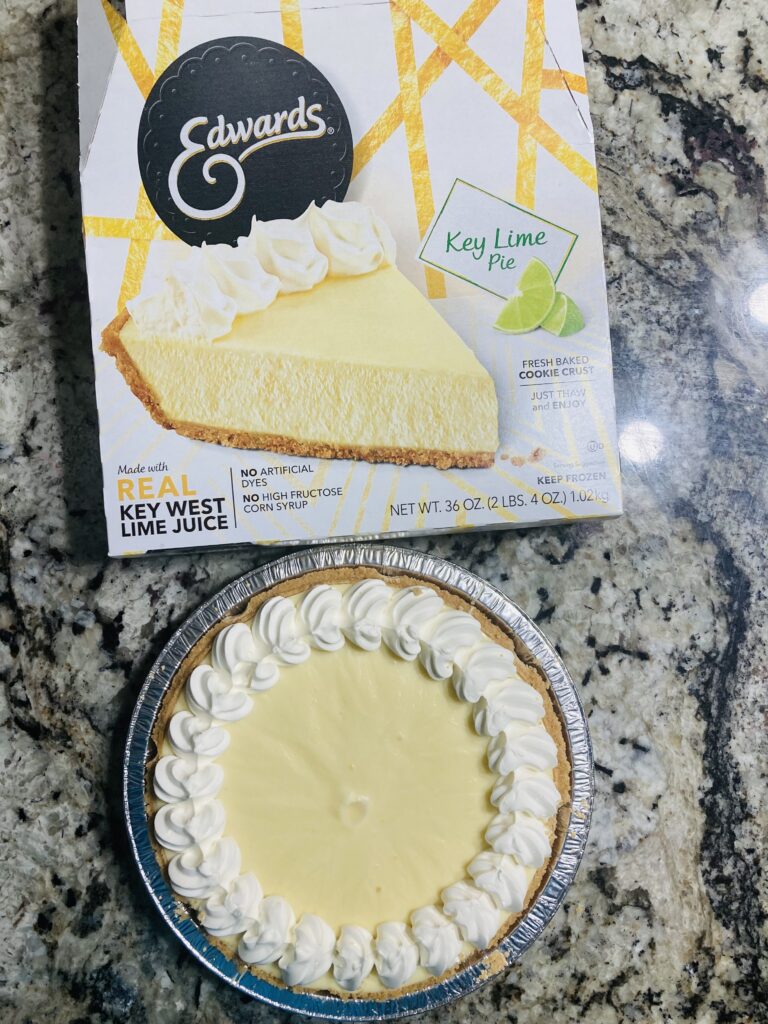
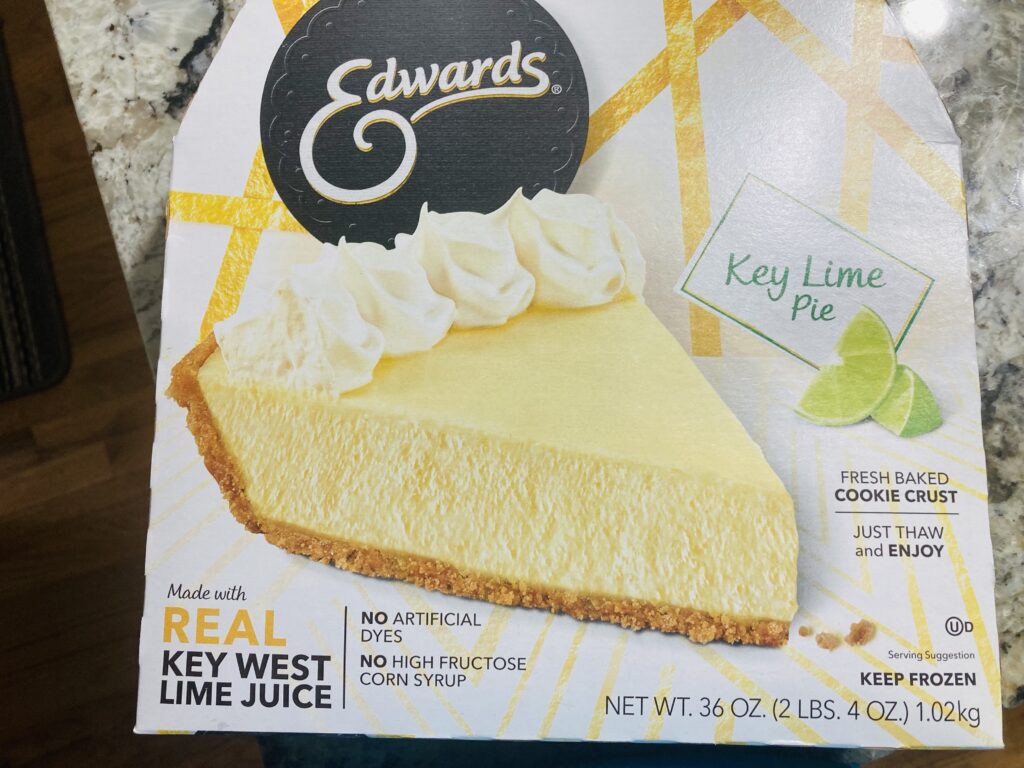
Disadvantages of using Key lime vs finger lime
| Key lime | Finger lime |
|---|---|
| Size and Presentation: Key limes are typically smaller and rounder. Their small size may make them less visually appealing for certain culinary applications where a larger or more distinctive appearance is desired. | Size and Presentation: Finger limes are elongated and have a caviar-like texture when cut open. Their unique appearance and texture can be an advantage for certain dishes or presentations. |
| Flavor Profile: Key limes have a distinctive flavor, which is often described as more tart and intense than the regular Persian limes. While this can be an advantage in some recipes, it might be a disadvantage for those looking for a milder citrus flavor | Flavor Profile: Finger limes have a unique burst of tangy citrus flavor with a hint of acidity. Some may prefer this flavor profile over the sharper taste of Key limes |
| Availability: Key limes are more widely available in many grocery stores, making them more accessible for consumers. However, this could be a disadvantage for those looking for a more exotic or unique citrus experience. | Availability: Finger limes were traditionally less common and might be harder to find in some regions. This can make them less convenient for those who don’t have access to specialty stores or farmers’ markets. |
| Cost: Key limes are generally more affordable than finger limes, which are considered a gourmet or specialty product. The cost factor may be a disadvantage for those on a budget | Cost: Finger limes are often more expensive due to their unique appearance, flavor, and limited availability. This can be a deterrent for some consumers or chefs looking to manage costs |
Common questions people ask about Key Limes vs. Finger Limes, along with answers:
1. Which is more acidic: Key Lime or Finger Lime?
- Key Limes tend to be more acidic with a sharp tartness, making them ideal for traditional lime flavor in cooking and cocktails.
- Finger Limes are also acidic but tend to have a milder, more subtle tartness that is balanced by a slightly sweet flavor.
2. Can you substitute Finger Limes for Key Limes in recipes?
Yes, but it depends on the recipe. Finger Limes are often used for their texture and visual appeal rather than their juice. If the recipe relies on lime juice (like Key Lime pie), Key Limes are a better choice. Finger Limes can be a fun substitute in salads, garnishes, or cocktails where texture and presentation are important.
3. What are the health benefits of Key Limes vs. Finger Limes?
Finger Limes: Also rich in vitamin C and antioxidants, with additional nutrients like folate and potassium. They are often praised for their unique texture, which can encourage eating more fresh fruits.
Key Limes: High in vitamin C, antioxidants, and dietary fiber, contributing to immune support, skin health, and digestive wellness.
4. Which lime is more commonly used in cooking?
Key Limes are more commonly used in cooking, especially in key lime pies, marinades, and cocktails like margaritas.
Finger Limes are primarily used in gourmet dishes and as a garnish, adding a burst of flavor and texture to seafood, desserts, and drinks.
5. Where do Key Limes and Finger Limes originate?
Key Limes: Originally from Southeast Asia, they became popular in the Florida Keys, which is how they got their name.
Finger Limes: Native to the rainforests of Australia, they are a type of “bushfood” traditionally used by Indigenous Australians.
6. How do you store Key Limes and Finger Limes?
Key Limes: Store at room temperature if you plan to use them within a few days, or refrigerate them for up to two weeks.
Finger Limes: Best stored in the refrigerator, where they can last up to 3 weeks. They can also be frozen for longer storage without losing their unique texture.
7. What do Key Limes and Finger Limes taste like?
Key Limes: Tart and slightly bitter, with a strong lime flavor.
Finger Limes: Tangy and citrusy with a subtle sweetness, often described as having a more complex flavor profile.
8. Can you grow Key Limes and Finger Limes at home?
Key Limes: Yes, they can be grown in warm, sunny climates or indoors in containers in cooler climates.
Finger Limes: Yes, they can be grown in similar conditions but require more care and specific growing conditions related to their native Australian environment. They are also slower-growing and more challenging to cultivate.
Resources
https://www.webmd.com/diet/health-benefits-limes
https://www.riverford.co.uk/recipes/finger-lime-chocolate-miso-cheesecake
https://en.wikipedia.org/wiki/Citrus_australasica#Description
